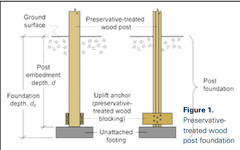woodcomputer
Computer
- Jan 13, 2025
- 1
I am a software engineer developing a design calculator for wood-frame embedded column structures in the United States pursuant to the IBC using allowable stress design. In reading the IBC (I am currently looking at the 2021 edition, but I believe the following applies in some form to all editions in active use) for provisions related to embedded post design, I have found two relevant sections.
IBC Section 2306.1 defers design of embedded post foundation structures to ASABE EP486.3, published in 2017 and reaffirmed in 2021. Older editions of the IBC in their counterpart sections defer to the previous standard ASABE EP486.2 published in 2012, which is broadly similar to EP486.3.
However, earlier in the IBC, under Section 1807.3, there are much simpler provisions for embedded post design. Among the computations include equations for uplift design that I have traced all the way back to the 1964 Uniform Building Code, which themselves are based on research conducted by P.C. Rutledge back in the 1930s. This is the very same research that was used by the original published ASABE EP486 standard back in 1997, which has been superseded by the later editions which are based on more modern research.
I am a bit confused by the apparent overlap of design provisions. Personally, I would lean towards the more modern and ostensibly more rigorous approach of the EP486.2/EP486.3 standards cited by IBC Section 2306.1. But why, then, are the much older provisions of Section 1807.3 still included? Are they considered acceptable alternatives to the more rigorous principles? Are they a tradeoff of less computational effort at the cost of more conservative design? Or is there some detail that makes one section uniquely applicable in some cases while the other section is applicable in others that I am not seeing? Both sets of provisions are explicitly permitted for use with ASD in the IBC, so if there is a difference, that isn't it.
IBC Section 2306.1 defers design of embedded post foundation structures to ASABE EP486.3, published in 2017 and reaffirmed in 2021. Older editions of the IBC in their counterpart sections defer to the previous standard ASABE EP486.2 published in 2012, which is broadly similar to EP486.3.
However, earlier in the IBC, under Section 1807.3, there are much simpler provisions for embedded post design. Among the computations include equations for uplift design that I have traced all the way back to the 1964 Uniform Building Code, which themselves are based on research conducted by P.C. Rutledge back in the 1930s. This is the very same research that was used by the original published ASABE EP486 standard back in 1997, which has been superseded by the later editions which are based on more modern research.
I am a bit confused by the apparent overlap of design provisions. Personally, I would lean towards the more modern and ostensibly more rigorous approach of the EP486.2/EP486.3 standards cited by IBC Section 2306.1. But why, then, are the much older provisions of Section 1807.3 still included? Are they considered acceptable alternatives to the more rigorous principles? Are they a tradeoff of less computational effort at the cost of more conservative design? Or is there some detail that makes one section uniquely applicable in some cases while the other section is applicable in others that I am not seeing? Both sets of provisions are explicitly permitted for use with ASD in the IBC, so if there is a difference, that isn't it.


